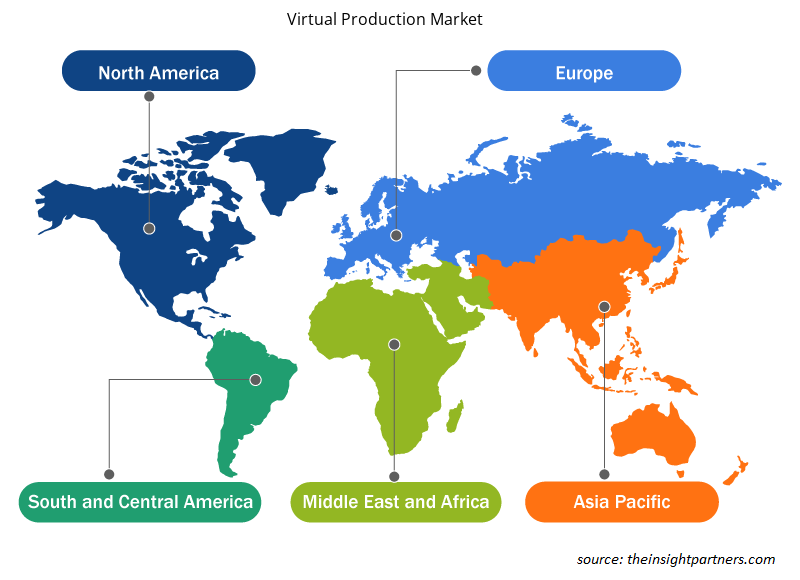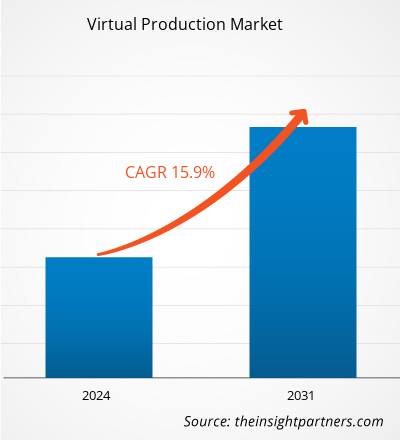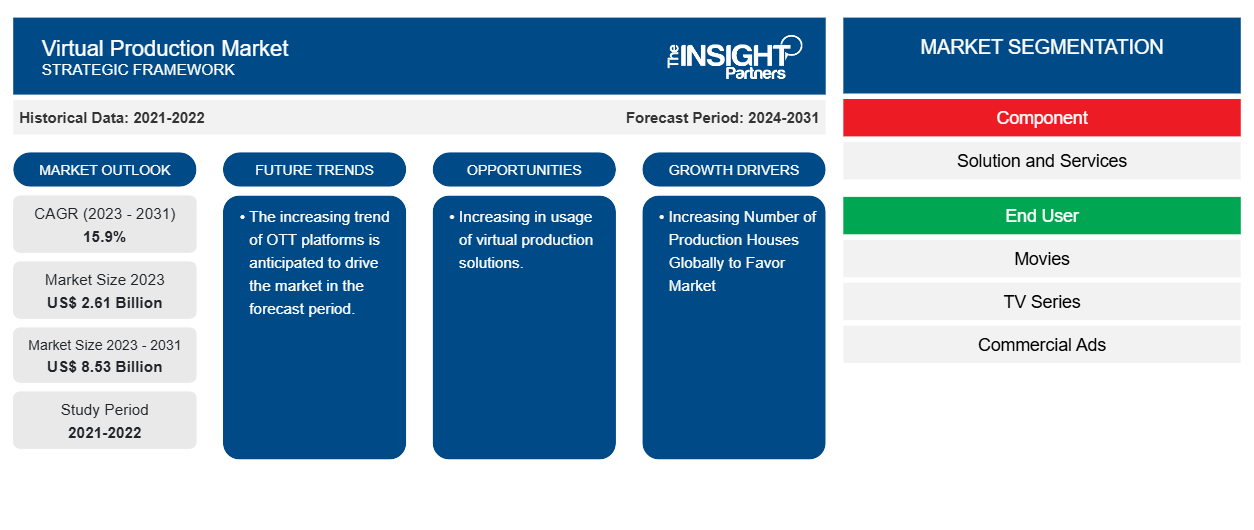Se prevé que el tamaño del mercado de producción virtual alcance los 8.530 millones de dólares en 2031, frente a los 2.610 millones de dólares en 2023. Se espera que el mercado registre una CAGR del 15,9 % durante el período 2023-2031. Es probable que el creciente número de productoras a nivel mundial y el mayor ahorro de costes y tiempo para las productoras y los creadores de contenido sigan siendo tendencias clave y factores impulsores del mercado.
Análisis del mercado de producción virtual
El mercado de producción virtual está experimentando un crecimiento significativo a nivel mundial. Este crecimiento se atribuye al creciente número de productoras a nivel mundial y al mayor ahorro de tiempo y costos para las productoras y los creadores de contenido. Además, se prevé que el uso creciente de soluciones de producción virtual y la tendencia creciente de las plataformas OTT brinden varias oportunidades para el mercado de producción virtual.
Panorama general del mercado de producción virtual
La producción virtual es una tecnología de producción de medios en la que se muestra un escenario virtual en grandes paredes LED detrás de un escenario físico. Los equipos utilizan motores 3D en tiempo real (motores de juegos) para crear un escenario virtual, mostrarlo en la pared LED y luego sincronizar los motores con las cámaras del escenario para lograr un mayor realismo y profundidad de perspectiva.
Personalice este informe según sus necesidades
Obtendrá personalización en cualquier informe, sin cargo, incluidas partes de este informe o análisis a nivel de país, paquete de datos de Excel, así como también grandes ofertas y descuentos para empresas emergentes y universidades.
-
Obtenga las principales tendencias clave del mercado de este informe.Esta muestra GRATUITA incluirá análisis de datos, desde tendencias del mercado hasta estimaciones y pronósticos.
Factores impulsores y oportunidades del mercado de producción virtual
Aumenta el número de productoras a nivel mundial para favorecer el mercado
El creciente número de casas productoras puede impulsar la producción virtual de diversas maneras. A medida que se construyen más casas productoras, aumenta la demanda de métodos de producción eficientes y rentables. La producción virtual permite a las casas productoras construir más, innovar más y ofrecer resultados de alta calidad en una etapa más temprana del proceso de producción. Además, la producción virtual también ahorra tiempo y costos para muchas casas productoras. La exploración virtual que genera versiones virtuales de los decorados propuestos puede reducir el tiempo de viaje y los gastos adicionales. Tomar decisiones innovadoras en una etapa más temprana del proceso garantiza que se puedan tomar las decisiones correctas. Por lo tanto, considerando los parámetros anteriores, el creciente número de casas productoras a nivel mundial está impulsando el crecimiento del mercado de la producción virtual.
Aumento del uso de soluciones de producción virtual.
Se prevé que el uso cada vez mayor de soluciones de producción virtual brinde varias oportunidades para el mercado de producción virtual. Varias industrias están implementando la producción virtual, lo que aumenta la demanda de soluciones de producción virtual. Esto puede atraer nuevos actores e inversiones, lo que genera innovaciones y expansión. Además, la producción virtual se está utilizando no solo en los medios y el entretenimiento, sino también en la publicidad , los eventos en vivo, los juegos y otros. Esta variedad de producción virtual puede abrir nuevas fuentes de ingresos y clientes.
Análisis de segmentación del informe del mercado de producción virtual
Los segmentos clave que contribuyeron a la derivación del análisis del mercado de producción virtual son los componentes y los usuarios finales.
- Según los componentes, el mercado de producción virtual se divide en soluciones y servicios. Se prevé que el segmento de soluciones ocupe una cuota de mercado significativa en el período de pronóstico.
- Según el usuario final, el mercado de producción virtual se divide en películas, series de televisión, anuncios comerciales y videos en línea. Se prevé que las películas ocupen una cuota de mercado significativa en el período de pronóstico.
Análisis de la cuota de mercado de producción virtual por geografía
El alcance geográfico del informe del mercado de producción virtual se divide principalmente en cinco regiones: América del Norte, Asia Pacífico, Europa, Medio Oriente y África, y América del Sur y Central.
El mercado de producción virtual de América del Norte ha dominado. Este mercado está segmentado en Estados Unidos, Canadá y México. Además, el mercado está experimentando un crecimiento significativo, que se atribuye al creciente número de casas de producción a nivel mundial y al mayor ahorro de costos y tiempo para las casas de producción y los creadores de contenido en la región. Además, se prevé que el uso creciente de soluciones de producción virtual y la tendencia creciente de las plataformas OTT brinden varias oportunidades para el mercado de producción virtual de América del Norte. Además, un fuerte énfasis en la investigación y el desarrollo en las economías desarrolladas de Estados Unidos y Canadá está obligando a los actores norteamericanos a traer soluciones tecnológicamente avanzadas al mercado. Además, Estados Unidos tiene una gran cantidad de actores del mercado de producción virtual que se han centrado cada vez más en el desarrollo de soluciones innovadoras. Todos estos factores contribuyen al crecimiento del mercado de producción virtual de la región.
Producción virtual
Perspectivas regionales del mercado de producción virtual
Los analistas de Insight Partners explicaron en detalle las tendencias y los factores regionales que influyen en el mercado de producción virtual durante el período de pronóstico. Esta sección también analiza los segmentos y la geografía del mercado de producción virtual en América del Norte, Europa, Asia Pacífico, Oriente Medio y África, y América del Sur y Central.

- Obtenga los datos regionales específicos para el mercado de producción virtual
Alcance del informe sobre el mercado de producción virtual
| Atributo del informe | Detalles |
|---|---|
| Tamaño del mercado en 2023 | US$ 2.61 mil millones |
| Tamaño del mercado en 2031 | US$ 8,53 mil millones |
| CAGR global (2023 - 2031) | 15,9% |
| Datos históricos | 2021-2022 |
| Período de pronóstico | 2024-2031 |
| Segmentos cubiertos |
Por componente
|
| Regiones y países cubiertos |
América del norte
|
| Líderes del mercado y perfiles de empresas clave |
|
Densidad de actores del mercado de producción virtual: comprensión de su impacto en la dinámica empresarial
El mercado de producción virtual está creciendo rápidamente, impulsado por la creciente demanda de los usuarios finales debido a factores como la evolución de las preferencias de los consumidores, los avances tecnológicos y una mayor conciencia de los beneficios del producto. A medida que aumenta la demanda, las empresas amplían sus ofertas, innovan para satisfacer las necesidades de los consumidores y aprovechan las tendencias emergentes, lo que impulsa aún más el crecimiento del mercado.
La densidad de actores del mercado se refiere a la distribución de las empresas o firmas que operan dentro de un mercado o industria en particular. Indica cuántos competidores (actores del mercado) están presentes en un espacio de mercado determinado en relación con su tamaño o valor total de mercado.
Las principales empresas que operan en el mercado de producción virtual son:
- 360Rize
- INSTA 360
- BorisFX
- Juegos épicos; Inc.
- Tecnología Brompton Ltd.
- Adobe Inc.
Descargo de responsabilidad : Las empresas enumeradas anteriormente no están clasificadas en ningún orden particular.

- Obtenga una descripción general de los principales actores clave del mercado de producción virtual
Noticias y desarrollos recientes del mercado de producción virtual
El mercado de producción virtual se evalúa mediante la recopilación de datos cualitativos y cuantitativos a partir de investigaciones primarias y secundarias, que incluyen publicaciones corporativas importantes, datos de asociaciones y bases de datos. A continuación se enumeran algunos de los avances en el mercado de producción virtual:
- Dimension anunció el lanzamiento de DNEG 360, que combina la experiencia de Dimension en producción en tiempo real con los servicios de entretenimiento visual líderes a nivel mundial de DNEG. Junto con el lanzamiento de DNEG 360, la empresa ha lanzado un exclusivo video detrás de escena: "La evolución de la producción virtual", para mostrar sus técnicas y avances avanzados en producción virtual. (Fuente: sitio web de Dimension Company, abril de 2024)
- Vancouver Film School se asoció con Pixomondo (PXO) para ofrecer una nueva oferta a los estudiantes de VFS. Virtual Art Department Content Creation es un programa de certificación de 12 semanas desarrollado por Pixomondo para enseñar a los creativos los fundamentos de la creación de contenido para la producción virtual en efectos visuales. (Fuente: sitio web de la empresa Pixomondo (PXO), abril de 2024)
Informe sobre el mercado de producción virtual: cobertura y resultados
El informe “Tamaño y pronóstico del mercado de producción virtual (2021-2031)” proporciona un análisis detallado del mercado que cubre las siguientes áreas:
- Tamaño y pronóstico del mercado de producción virtual a nivel global, regional y nacional para todos los segmentos clave del mercado cubiertos bajo el alcance.
- Tendencias del mercado de producción virtual, así como dinámica del mercado, como impulsores, restricciones y oportunidades clave.
- Análisis detallado PEST/Cinco fuerzas de Porter y FODA.
- Análisis del mercado de producción virtual que cubre las tendencias clave del mercado, el marco global y regional, los principales actores, las regulaciones y los desarrollos recientes del mercado.
- Análisis del panorama de la industria y la competencia que cubre la concentración del mercado, el análisis de mapas de calor, los actores destacados y los desarrollos recientes para el mercado de producción virtual.
- Perfiles detallados de empresas.
- Análisis histórico (2 años), año base, pronóstico (7 años) con CAGR
- Análisis PEST y FODA
- Tamaño del mercado, valor/volumen: global, regional y nacional
- Industria y panorama competitivo
- Conjunto de datos de Excel
Informes recientes
Testimonios
Razón para comprar
- Toma de decisiones informada
- Comprensión de la dinámica del mercado
- Análisis competitivo
- Información sobre clientes
- Pronósticos del mercado
- Mitigación de riesgos
- Planificación estratégica
- Justificación de la inversión
- Identificación de mercados emergentes
- Mejora de las estrategias de marketing
- Impulso de la eficiencia operativa
- Alineación con las tendencias regulatorias























 Obtenga una muestra gratuita para - Mercado de producción virtual
Obtenga una muestra gratuita para - Mercado de producción virtual